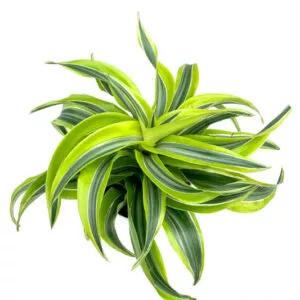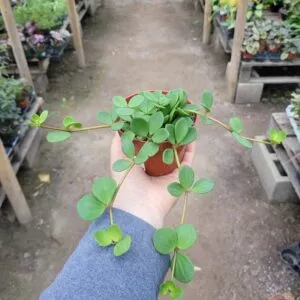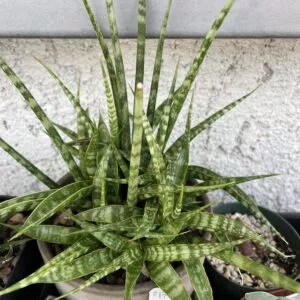No products in the cart.
Table of Contents
Okay, this plant is something different yet spectacular to have as an indoor plant. So, if you are looking for a plant with a twist, this curly spider plant is for you. Some people refer to it as Chlorophytum comosum ‘Bonnie.’
You can find this plant in a green and variegated form with white stripes located in the leaf center.
About Bonnie Curly Spider Plant
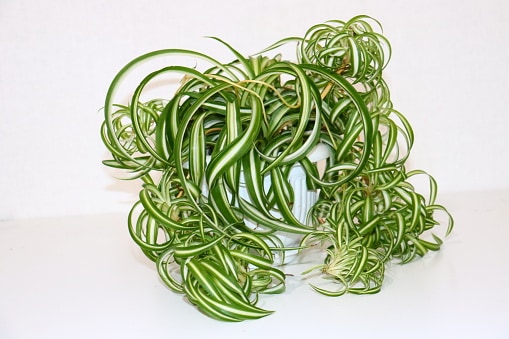
The curly spider plant looks similar to the spider plants. The only difference is the leaves curl at the end. The plant looks fabulous in a hanging basket or placed on a tabletop in a decorative pot. The lovely houseplant comes from Africa and is part of the Asparagaceae family.
The Bonnie curly spider plant grows more compact to eight inches tall and has curly leaves compared to the spider plant. Unfortunately, when grown indoors, it seldom flowers. Yet, it can produce small star-shaped white flowers with a fragrance when grown outdoors.
The flower attracts pollinators like hummingbirds and bees and blooms from spring to summer.
Curly Spider Care
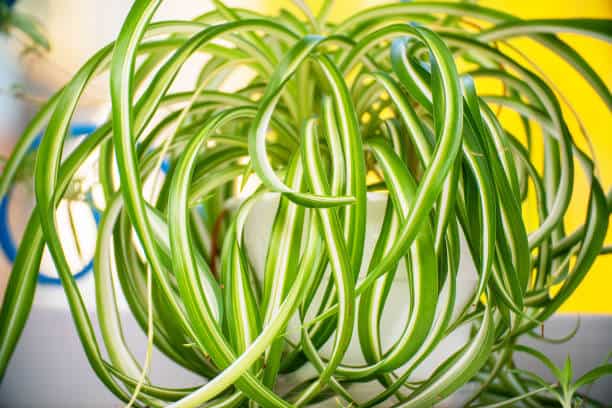
The curly spider plant is one of the easiest plants to care for. The best part is that it is an air purifying plant and goes by the name airplane plant. So, let’s get started on caring for this gorgeous plant.
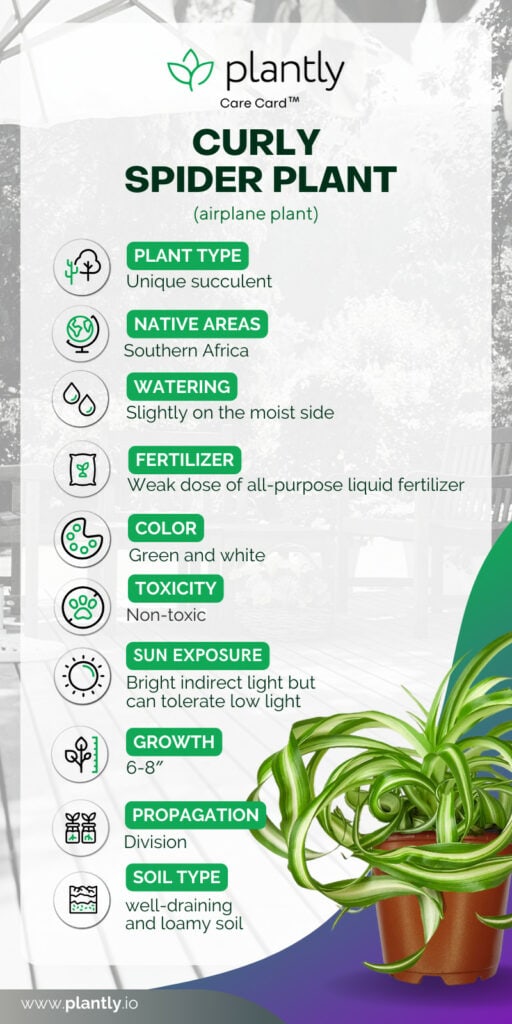
Soil Mix for Curly Spider Plant
Like your other spider plant, the Bonnie loves well-draining soil but also needs to hold some moisture. So, you can create an ideal potting mix for most spider plants in hanging baskets.
The most uncomplicated soil mix is three parts potting mix with one part perlite, and you can add some compost.
Alternatively, you can use succulent soil with some peat moss or coco coir. We do not advise using only a standard potting soil as it retains too much water.
Neither should you use a cactus mix on its own as your plant thrives in moist soil.
Curly Spider Sunlight Needs
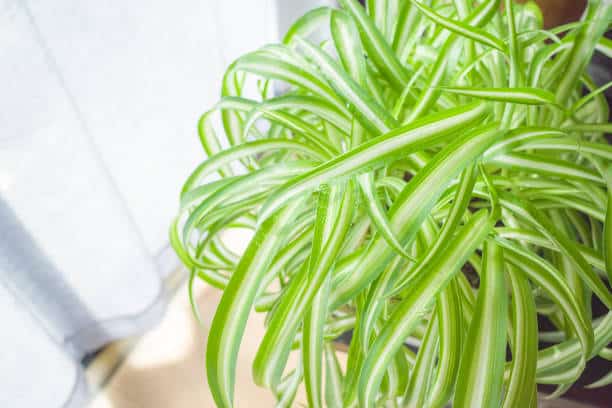
It is not too fussy when it comes to caring for the curly spider plant and light. Yet, it grows best in bright indirect light but can tolerate low light well. It will develop a bit slower with less light, but there is not much difference in the leaf color.
Hence, you can regulate the light allowing your Bonnie curly spider plant not to get too dense. But the same does not apply with direct sunlight, as more than three hours of full sun can affect the leaves.
So direct sun can lead to the foliage developing brown tips and spots. It is best to provide your spider plants with partial to full shade for when treated as an outdoor plant.
Watering Needs for Chlorophytum Comosum Bonnie
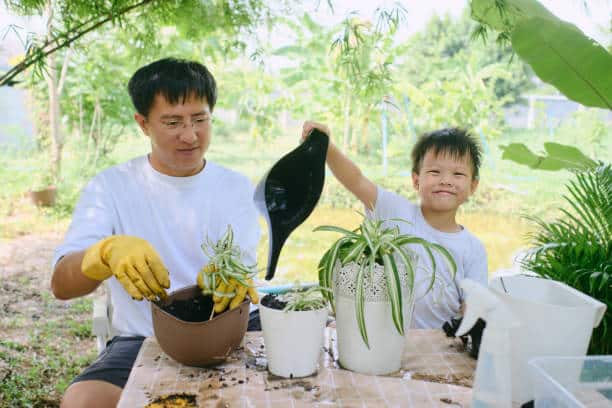
Even watering your plant is low maintenance. The plant is drought-tolerant, and overwatering the spider plants is the biggest concern. You can let the soil dry out between watering by testing the soil with your finger.
Then you can drench the root ball and allow the excess water to run out from the drainage holes in the pot. Still, if you notice brown tips on the leaves, check the chemicals in the water you provide.
Your plant is sensitive to the minerals in tap water like chlorine and fluoride. Some municipalities have a lot of these in the water. If the leaf tips turn brown, we recommend leaving the water standing overnight for the chemicals to evaporate.
Or you can use distilled water or rainwater where possible.
Temperature & Humidity
One thing that you will love about this tropical plant is that it feels right at home in your living space. The ideal temperature for Bonnie spider plants is between 60°F to 80°F. The ideal conditions are around 50°F and above.

Your plant is not cold hardy and cannot tolerate frost or freezing temperature. Yet, if you live in USDA hardiness zones 9 to 11, you can keep your spider plant in a decorative pot outside.
But below zone nine, your plant becomes an annual move indoors to have a healthy plant. The Bonnie enjoys medium to high moisture levels when it comes to humidity. So if you notice the leaf tips turn brown, it is a sign your Bonnie needs more moisture.
A great way to provide added moisture is by grouping your tropical beauty with other humidity-loving plants. Or you can use a humidifier or a pebble tray placed underneath it.
Fertilizing Curly Spider Plant
For feeding your Bonnie spider plant, you can use an all-purpose feed. You can apply the fertilizer once a month in the growing season at half strength. The airplane plant is not a heavy feeder, so it is best to avoid overfeeding as it can damage the roots.
Repot and Pruning
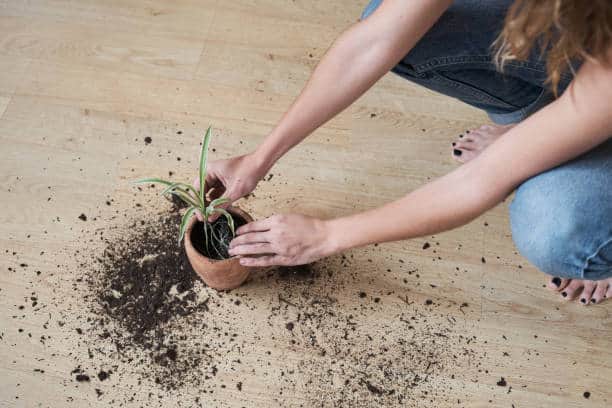
Your plant needs transplanting once a year, but it is only a guideline you can use. So instead, look at what your Bonnie needs. Once you notice your Bonnie becoming pot bound, you can transplant it to a size bigger pot.
Compared to the spider plant, your Bonnie is small and compact. You can still give it a pruning to prevent it from growing too thick and messy. Hence, you can appreciate the curls of the white stripe variegation.
Propagating Curly Spider Plants
Propagation is the best way to ensure you always have the Bonnie in your home. The standard propagation method is through division or the plantlets. In contrast, the plantlets are a straightforward technique but take longer.
Your mature plants produce plantlets naturally in their own time. If you use the plantlets, you need to wait until it grows a few leaves with roots before separating them from the mother plant. Another excellent method is division and faster.
When using the division technique, you need to remove the mother plant from the pot and separate it into three sections. Then place each plantlet into an individual container and care for the parent plant.
Spider Plant Varieties
When it comes to the spider plant, you have a considerable variety to grow as houseplants.
Chlorophytum Comosum ‘Reverse Variegatum.’
The reverse spider plant is the opposite of the curly variegated species. The leaves have a yellow edge and a green center. It can also grow large and adds variety to a garden.
Chlorophytum laxum
The zebra plant has more prominent foliage that is brighter, and it grows wide instead of tall. It is a rare species not easily found in a local nursery.
Chlorophytum viridescens ‘Hawaiian.’
The Hawaiian is also known as the Golden Glow with glossy green leaves. It is a small compact plant that grows well in moist soil that drains well and thrives in partial shade.
Curly Spider Diseases & Pests
When it comes to your houseplant, it can be bothered by aphids, mealybugs, and spider mites. If you have high humidity, it can result in fungus gnats. To keep your Bonnie healthy, you can use some neem oil or insecticidal soap. The most common disease is root rot from overwatering or not having a well-drained solid.
Frequently Asked Questions
If your spider plant is very twirly, it is the curly type that looks like the variegated spider plant, except the leaves twist, and the offspring also grows winded.
When you attend to your plant too much, the leaves can become straighter. Even a drier potting mix will help the foliage curl more but not too bone dry, or it may start browning or turning yellow.
Your houseplant can grow up to eight inches tall and wide and has compact growth.
Finding the curly spider plant at your local nursery is a challenge as it is a rare plant. But the fantastic news is that Plantly can help you to find one. So check out our selection here
Whether you want to buy, sell or simply reach out to other plant enthusiasts, Plantly is the right place to be!
In stock In stock In stock In stock
Free Shipping
$23.00
Sold By:
Gar-Zen Botanical Design
Dwarf Chenille Plant Red Hot Cat Tails Ships Free.
Only 15 available and it’s in 1 people’s basket Rated 4.86 out of 5 based on 49 customer ratings01
Sold By:
Gar-Zen Botanical Design
$9.95
Sold By:
CTS Air Plants
Dracaena Lemon Surprise Houseplants
Only 20 available and it’s in 1 people’s basket
Sold By:
CTS Air Plants
$6.00 – $12.00
Sold By:
Plants by Stinky Boo
Peperomia Hope
Only 20 available and it’s in 2 people’s basket Rated 5.00 out of 5 based on 2 customer ratings00
Sold By:
Plants by Stinky Boo
$12.00
Sold By:
Beauties & Beasts
Cactus Succulent- Sansevieria fernwood -Succulet
Rated 4.83 out of 5 based on 24 customer ratings00
Sold By:
Beauties & Beasts

